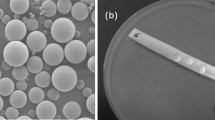Abstract
Plastic scintillation foils of polystyrene and polycarbonate with a thickness between 45 and 200 μm, have been produced using the solvent evaporation method. PSfoils presented a reproducible thickness (10–20%). PSfoils were characterized by the measurement of 36Cl or 241Am. For 36Cl spectrum is located at medium energies since not all energy is deposited in the scintillator and not all betas interact with the foils. For 241Am the efficiency values are very high and spectrum is a sharp peak located at high energies. 222Rn absorption (LD and K) and desorption capacities of the PSfoils have been also evaluated.








Similar content being viewed by others
References
Hsu J, Krieger JK (1991) Mixed waste: a review from a generators perspective. In: Ross H, Noakes JE, Spaulding JD (eds) International conference on new trends in liquid scintillation counting and organic scintillators. Lewis Publishers, Boca Raton, pp 557–600
Schorr MG, Torney FL (1950) Solid non-crystalline scintillation phosphors. Phys Rev 80:474
Koski WS (1951) Scintillations in some phosphor-plastic systems. Phys Rev 82:230–232
Kallmann H (1950) Scintillation counting with solutions. Phys Rev 78:621–622
Birks JB (1964) The theory and practice of scintillation counting. Pergamon Press, Oxford
Brooks FD, Pringle RW, Funt BL (1960) Pulse shape discrimination in a plastic scintillator. IRE Trans Nucl Sci 7:35–38. https://doi.org/10.1109/TNS2.1960.4315733
Bertrand GHV, Hamel M, Sguerra F (2014) Current status on plastic scintillators modifications. Chemistry 20:15660–15685. https://doi.org/10.1002/chem.201404093
Zaitseva N, Rupert BL, PaweLczak I et al (2012) Plastic scintillators with efficient neutron/gamma pulse shape discrimination. Nucl Instrum Methods Phys Res 668:88–93. https://doi.org/10.1016/j.nima.2011.11.071
Beddar AS (2006) Plastic scintillation dosimetry and its application to radiotherapy. Radiat Meas 41(1):124–133. https://doi.org/10.1016/j.radmeas.2007.01.002
Boivin J, Beddar S, Bonde C (2016) Review of plastic and liquid scintillation dosimetry for photon, electron, and proton therapy. Phys Med Biol 61(20):305–343. https://doi.org/10.1088/0031-9155/61/20/R305
Roane JE, DeVol TA (2002) Simultaneous separation and detection of actinides in acidic solutions using an extractive scintillating resin. Anal Chem 74:5629–5634
Tarancón A, Bagán H, García JF (2017) Plastic scintillators and related analytical procedures for radionuclide analysis. J Radioanal Nucl Chem 314(2):555–572. https://doi.org/10.1007/s10967-017-5494-5
Egorov OB, Fiskum SK, O’Hara MK, Grate JW (1999) Radionuclide sensors based on chemically selective scintillating microspheres: renewable column sensor for analysis of 99Tc in water. Anal Chem 71:5420–5429
Bosworth N, Towers P (1989) Scintillation proximity assay. Nature 341:167–168
L’Annunziata MF (2013) Handbook of radioactivity analysis. Academic Press, San Diego
Das S, Chakraborty S, Sodaye S et al (2010) Scintillating adsorptive membrane for preconcentration and determination of anionic radionuclides in aqueous samples. Anal Methods 2:728. https://doi.org/10.1039/b9ay00269c
Chavan V, Agarwal C, Pandey AK (2016) Pore-filled scintillating membrane as sensing matrix for α-emitting actinides. Anal Chem 88:3796–3803. https://doi.org/10.1021/acs.analchem.5b04827
Santiago LM, Tarancón A, García JF (2016) Influence of preparation parameters on the synthesis of plastic scintillation microspheres and evaluation of sample preparation. Adv Powder Technol 27:1309–1317. https://doi.org/10.1016/j.apt.2016.04.025
Barrera J, Tarancón A, Bagán H, García JF (2016) A new plastic scintillation resin for single-step separation, concentration and measurement of technetium-99. Anal Chim Acta 936:259–266. https://doi.org/10.1016/j.aca.2016.07.008
Warwick PE, Croudace IW (2017) Rapid on-site radionuclide screening of aqueous waste streams using dip-stick technologies and liquid scintillation counting. J Radioanal Nucl Chem 314(2):761–766. https://doi.org/10.1007/s10967-017-5413-9
Pelay E, Tarancón A, Mitev K et al (2017) Synthesis and characterisation of scintillating microspheres made of polystyrene/polycarbonate for 222Rn measurements. J Radioanal Nucl Chem 314(2):637–649. https://doi.org/10.1007/s10967-017-5488-3
Mitev K, Cassette P, Georgiev S et al (2016) Determination of 222Rn absorption properties of polycarbonate foils by liquid scintillation counting. Application to 222Rn measurements. Appl Radiat Isot 109:270–275. https://doi.org/10.1016/j.apradiso.2015.11.047
Pressyanov D, Mitev K, Georgiev S, Dimitrova I (2009) Sorption and desorption of radioactive noble gases in polycarbonates. Nucl Instrum Methods Phys Res 598:620–627. https://doi.org/10.1016/j.nima.2008.09.044
Acknowledgements
We thank the Spanish Ministerio de Economia, Industria y Competitividad (MINECO) for financial support under award CTM2017-87107-R, and the Catalan Agència de Gestió d’Ajuts Universitaris i de Recerca (AGAUR) for financial support under award 2017-SGR-907.
Author information
Authors and Affiliations
Corresponding author
Rights and permissions
About this article
Cite this article
Merín, R., Tarancón, A., Mitev, K. et al. Evaluation of synthesis conditions for plastic scintillation foils used to measure alpha- and beta-emitting radionuclides. J Radioanal Nucl Chem 319, 135–145 (2019). https://doi.org/10.1007/s10967-018-6341-z
Received:
Published:
Issue Date:
DOI: https://doi.org/10.1007/s10967-018-6341-z




